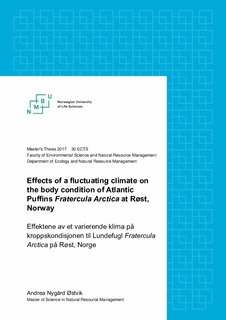| dc.contributor.advisor | Dale, Svein | |
| dc.contributor.advisor | Steen, Ronny | |
| dc.contributor.advisor | Anker-Nilssen, Tycho | |
| dc.contributor.advisor | Røstad, Ole-Wiggo | |
| dc.contributor.author | Østvik, Andrea Nygård | |
| dc.coverage.spatial | Norway | nb_NO |
| dc.date.accessioned | 2017-10-20T12:12:12Z | |
| dc.date.available | 2017-10-20T12:12:12Z | |
| dc.date.issued | 2017 | |
| dc.identifier.uri | http://hdl.handle.net/11250/2461293 | |
| dc.description.abstract | The Atlantic puffin fratercula arctica population is declining in the North Sea- and the Norwegian Sea region. Puffin colonies located in the Røst Archipelago at the outermost tip of the Lofoten Islands, experienced almost complete reproductive failures every year from 2006 until 2016. The present situation in the puffin colonies at Røst is closely related to the life history of a puffin. Puffins are considered a “K-selected” species and are therefore recognized for having long generation times, low reproductive rates, and a delayed onset of reproduction.
According to life history theory, adult puffins evaluate their chances of survival and reproduction during all stages of the breeding season in order to maximize their total reproductive success. In this trade-off between reproduction and survival, the body condition of puffins may influence the allocation of resources. The aim of this study was to examine whether and how the body condition of breeding puffins is influenced by climatic conditions, both within the breeding season and between years. To that objective, the relationship between body condition of adult puffins and environmental variables such as sea surface temperature (SST), breeding success, and 0-group herring abundance was tested in two separated periods of the breeding season. These periods included (1) the pre-laying period (before 15th of May), and (2) the period after the mean hatching date (in late June/July). I also used gender as an interactive covariate to test for sex-specific responses in explanatory variables. The residuals from a body size versus body mass regression was used as an index of body condition. A discriminant analysis showed that head+bill and wing length distinguished the sexes most precisely. The relationship between environmental variables and the body condition of adult puffins was analyzed in linear mixed effects models (LMM) using restricted maximum likelihood (REML). Akaike’s information criterion (AIC) was used in the model selection. The results suggested that the SST in March had a positive and significant impact on the body condition of adult puffins during all stages of the breeding season.
Fledging success was found to be positively correlated with body condition in the pre-laying period. However, the effect turned in the period after mean hatching date. I could not detect a significant difference in the body condition responses of female and male puffins. Moreover, 0-group herring abundance had no effect on body condition in the pre-laying period, whereas a minor negative, but significant impact could be found in the later stages of the breeding season. The body condition of adult puffins was found to be lower in the pre-laying period than in the period after mean hatching date. This study contributes to the understanding of the physiological responses of puffins to fluctuating environmental conditions by exploring variations in their body condition, as well as inter-sexual differences in these responses. | nb_NO |
| dc.language.iso | eng | nb_NO |
| dc.publisher | Norwegian University of Life Sciences, Ås | nb_NO |
| dc.rights | Attribution-NonCommercial-NoDerivatives 4.0 Internasjonal | * |
| dc.rights.uri | http://creativecommons.org/licenses/by-nc-nd/4.0/deed.no | * |
| dc.subject | fledging success | nb_NO |
| dc.subject | sea surface temperature | nb_NO |
| dc.subject | atlantic puffin | nb_NO |
| dc.subject | first-year herring abundance | nb_NO |
| dc.subject | sexual differences | nb_NO |
| dc.subject | body condition | nb_NO |
| dc.title | Effects of a fluctuating climate on the body condition of Atlantic Puffins Fratercula Arctica at Røst, Norway | nb_NO |
| dc.type | Master thesis | nb_NO |
| dc.description.version | submittedVersion | nb_NO |
| dc.subject.nsi | VDP::Matematikk og Naturvitenskap: 400 | nb_NO |
| dc.source.pagenumber | 44 | nb_NO |
| dc.relation.project | Norsk Institutt for Naturforskning: 12696000 | nb_NO |
| dc.description.localcode | M-NF | nb_NO |

